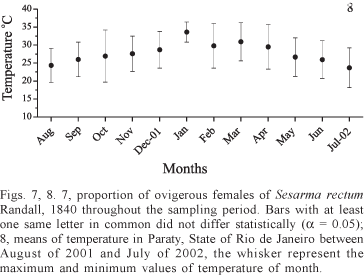A population of Sesarma rectum Randall, 1840 under the influence of human impact was studied. Monthly sampling (CPUE, two people during 30 min) took place from August/2001 to July/2002 at an impacted muddy flat in Paraty city, State of Rio de Janeiro (23º13'S, 44º42'W). At the laboratory, specimens were classified by sex and measured with a vernier caliper (0.01 mm). The size at the beginning of the sexual maturity was obtained by means of different techniques: in the case of males it was used the allometric procedure and the macroscopic analysis of gonads wile for females, the size of the smallest ovigerous female was also considered. The population structure was evaluated by means the analysis of the variations in the modes of the size frequency distribution. The fecundity was assessed using sub samples of the egg mass. For males, the macroscopic analyses of gonads revealed larger values of carapace width than those obtained with morphometric analysis. Males larger than 18.5 mm of carapace width can be considered as mature. For females, such size was 17.4 mm CW. Despite of the human impact in the habitat, the population presented to be stable, as indicated by a single mode on the size frequency distribution. The second mode that appeared in some months is probably related to the entrance of juveniles in the population. The sex ratio of this population is closely approximating to 1:1 until crabs reach a carapace width of about 28 mm; after that, males outnumbered females. Comparing the fecundity of the present population with a previous study from Ubatuba, it can be verified a difference in the number of eggs. The fecundity of Paraty's population is significantly lower than the Ubatuba's population. This is probably related to the scarcity of food resource in Paraty, once no vascular plant can be found in that place. The continuity of reproductive processes and the juvenile recruitment suggest this species is able to live in the area with human impact. The ability to obtaining nutrients from different source of food is probably a feature that allows S. rectum to occupy such impacted ecosystem.
Sexual maturity; allometric growth; population structure; fecundity











